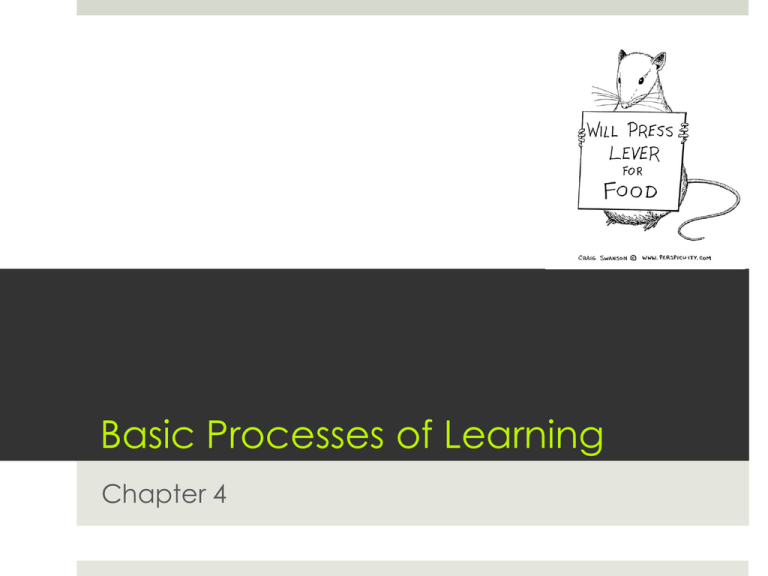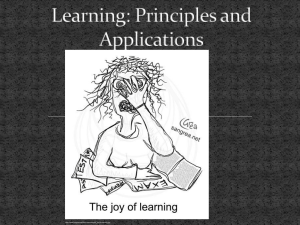CH 4: Learning
advertisement

Basic Processes of Learning Chapter 4 Principles of Learning The environment is always fluctuating LEARNING: the process or set of processes through which sensory experience at one time can affect an individual’s behavior at a future time Experience: any effects in the environment that are mediated by the individual’s sensory systems Classical Conditioning: Part I Classical conditioning is a learning process that creates new reflexes REFLEX: a simple, relatively automatic, stimulus-response sequence mediated by the nervous system Tap on the knee •Nerves •Spinal Cord Leg jerks forward HABITUATION: the decline in the magnitude or likelihood of a reflexive response that occurs when the stimulus is repeated several times in succession Pavlov’s Discovery Ivan Pavlov (1849-1936) Studied the reflexes involved in digestion Could some other stimulus be triggering the salivating response in dogs? Classical Conditioning Extinction and Recovery from Extinction • The gradual disappearance of a conditioned reflex that results when the CS occurs repeatedly without the UCS • The return-due to the passage of time with no further testing or training-of a CR that had previously undergone extinction Extinction and Spontaneous Recovery Generalization and Discrimination • The phenomenon by which a stimulus that resembles a CS will elicit the CR even though is has never been paired with the UCS • Procedure by which generalization between two stimuli is diminished or abolished by reinforcing the response to one stimulus and extinguishing the response to the other Classical Conditioning and Behaviorism BEHAVIORISM: (early 20th century) school of psychological thought that holds the proper subject of study is observable behavior, not the mind Behavior should be studied through an environmental context, not an internal, individualistic context John B. Watson Poor Little Albert… Stimulus-stimulus associatons Pavlov’s Stimulus-Stimulus Theory Watson’s Stimulus-Response Theory Learned Expectancy Rescorla (1998): Classical conditioning is not a stupid process by which the organism willy-nilly forms associations between any two stimuli that happen to cooccur. Rather, the organism is best seen as an information seeker using logical and perceptual relations among events, along with its own preconceptions, to form a sophisticated representation of its world. Translation: The dog expects the food. • Classical conditioning does not occur if the CS and UCS occur simultaneously or the CS follows the UCS • As the number of pairings increases, so does the strength of the association. Internal probability calculation? • The Blocking Effect – new stimulus presented with CS does not become a new CS. Conditioned Fear, Hunger and Sexual Arousal Conditioned Drug Reactions Drugs have two effects: the main effect and a compensatory effect that stabilizes the body DRUG TOLERANCE: the phenomenon by which a drug produces successively smaller physiological and behavioral effects, at any given dose, if it is taken repeatedly Overdosing A Clockwork Orange Operant Conditioning I OPERANT CONDITIONING: a training or learning process by which the consequence of a behavior response affects the likelihood that the individual will produce the response again Edward Thorndike (1898) Cats in the puzzle box LAW OF EFFECT: Responses that produce a satisfying effect in a particular situation become more likely to occur again in that situation Burrhus Frederic (“BF”) Skinner Researched and popularized the theory of operant conditioning Skinner box REINFORCER: any stimulus change that occurs after a response and tends to increase the likelihood that the response will be repeated Principles of Reinforcement How do you establish the first response? SHAPING: procedure in which successively closer approximations to the desired response are reinforced until the response finally occurs EXTINCTION: the decline in response rate that results when an operant response is no longer followed by a reinforcer Schedules of Partial Reinforcement (vs. continuous reinforcement) •A reinforcer occurs after every 9th response, where n is some whole number greater than 1 •The number of responses required before reinforcement varies unpredictably around some average •A fixed period of time elapses between one reinforced response and the next •The period of time that must elapse before a response will be reinforced varies unpredictably around some average Reinforcement and Punishment Positive (Introducing something) Negative (Removing something) Manipulation Goal INCREASES TARGET BEHAVIOR DECREASES TARGET BEHAVIOR Positive Reinforcement (Lever Press Food pellet) Positive Punishment (Lever Press Shock) + Add something good + Add something bad Negative Reinforcement (Lever Press Shock off) Negative Punishment (Lever Press removes food) - Take away something bad - Take away something good The Big Bang Theory https://www.youtube.com/watch?v=JA96Fba-WHk Operant Conditioning II Through discrimination training, an animal can be conditioned to make an operant response to a stimulus more specific than the entire inside of a Skinner Box. Discriminative stimulus GENERALIZATION The Overjustification Effect OVERJUSTIFICATION EFFECT: the phenomenon in which a person performs a task for no reward becomes less likely to perform that task for no reward after a period of time during which he or she has been rewarded for performing it Cognitive consequences of rewards Facilitating Learning: PLAY Exercise or activity for amusement or recreation; has no useful purpose Allows the animal to practice their instincts or species-specific behavior Groos’ Theory of Play 1. the young play more than adults 2. Species that have the most to learn play the most Play in humans: a form of imitation Facilitating Learning: EXPLORATION EXPLORATION: the investigation of unknown regions A more primitive form of learning A balance of curiosity and fear Exploration: Information Acquisition Tolman and Honzik (1930): Rewards affect what animals do more than what they learn LATENT LEARNING: learning that is not demonstrated in the subject’s behavior at the time that the learning occurs but can be inferred from its effect on the subject’s behavior at some later time Facilitating Learning: OBSERVATION OBSERVATIONAL LEARNING: learning by watching others Stimulus enhancement: increase in the salience or attractiveness of the object that the observed individual is acting upon Goal enhancement: an increased drive to obtain rewards similar to what the observed individual is receiving Food-Aversion Learning What is safe to eat? Most animals learn to avoid foods that have made them ill Food aversion differs from classical conditioning because: A significant time delay CS must be a taste or smell Food Preference Learning Animals must also learn to choose foods that satisfy a nutritional requirement, can associate certain foods with improvement in health Humans have a preference for high-calorie foods: (evolutionary advantageous)








